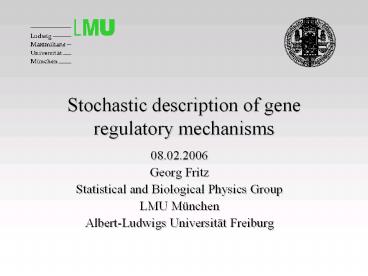Stochastic description of gene regulatory mechanisms - PowerPoint PPT Presentation
Title:
Stochastic description of gene regulatory mechanisms
Description:
Stochastic description of gene regulatory mechanisms 08.02.2006 Georg Fritz Statistical and Biological Physics Group LMU M nchen Albert-Ludwigs Universit t Freiburg – PowerPoint PPT presentation
Number of Views:115
Avg rating:3.0/5.0
Title: Stochastic description of gene regulatory mechanisms
1
Stochastic description of gene regulatory
mechanisms
- 08.02.2006
- Georg Fritz
- Statistical and Biological Physics Group
- LMU München
- Albert-Ludwigs Universität Freiburg
2
Outline
- Part I Simulation of stochastic chemical systems
with the Gillespie algorithm - Chemical master equation (CME)
- Reaction probability density function )
Gillespie algorithm - Part II Application to gene regulatory
mechanisms - Bistable autoregulatory network motif
- Deterministic description by ODEs
- Model reduction
- Fixedpoint analysis
- Stochastic simulation
- Glance at the C-code
- Timeseries fluctuation-driven transitions
between fixedpoints - Summary
3
Chemical master equation
- M reactions R?, N reactants Si with molecule
numbers Xi - Well stirred system, no spacial effects
considered - c? dt prob. of one reaction ? in dt, given one
reactant combination - h? number of distinct molecular reactant
combinations, e.g. h1X1 X2 - a? dt h? c? dt prob. that any reaction of the
type R? will occur in (t, tdt)
4
Chemical master equation
- Solution hard/impossible (for interesting
problems) - Use CME to derive time evolution of the moments
- Nonlinearities lead to involvement of higher
moments - Alternative Measure many realizations of the
stochastic process and estimate the quantity of
interest - ) Gillespie algorithm
5
The Gillespie algorithm Simulation of the
reaction probability density function
- Known as the BKL (Bortz-Kalos-Lebowitz) algorithm
in the physical literature - Equivalent to the chemical master equation
- Basic idea when will the next reaction occur,
what kind of reaction is it? - Described by the reaction probability density
function P(?,m) - P(?,?) d? prob. that, given the state
(X1,,XN) at time t, the next reaction will occur
in (t?,t?d?) and will be an R? reaction
D. Gillespie, Exact stochastic simulation of
coupled chemical reactions, J. Phys. Chem. 81,
1977
6
The reaction probability density function
- Goal determine P(?,m)
- P0(?) prob. that no reaction occurs in (t,
t?) - P0(?d?) P0(?) 1-??a? d?
- P(?,?) d? P0(?) a? d?
7
Simulation of P(?,m)
- Generate a random pair (?,?) according to
- Remember Wolframs talk generate r1,r2 2 UD(0,1)
and compute
8
The Algorithm
- Step 0 (Initialization) set the reaction rates
c1,,cM and the initial molecular population
numbers X1,,XN - Step 1 calculate the propensities a1h1c1, ,
aMhMcM and the total propensity a0 - Step 2 generate random numbers ? and ? according
to P(?,?) - Step 3 increase time t by ? and update molecule
numbers according to reaction ? - if t lt tint goto Step 1
9
Part II Application to autoregulatory genetic
network motif
transcription factor
translation
transcription
M. Ptashne and A. Gann, Imposing specificity by
localization mechanism and evolvability, Curr.
Biol., 1998, 8R812-R822
10
Positive autoregulation
- RNA polymerases large ) subsumed into
transcription rate - positive regulation c0 ltlt c1
- burst factor b c2/c9 determines the number of
proteins produced per mRNA
11
Deterministic approach model reduction
12
Fixedpoint analysis
for ?/? lt 2K both unstable for ?/? gt 2K one
stable, one unstable
stable
slope determined by ?/?
13
Stochastic simulation
- Step 0 (Initialization) set the reaction rates
c1,,cM and the initial molecular population
numbers X1,,XN - Step 1 calculate the propensities a1h1 c1, ,
aMhM cM and the total propensity a0 - Step 2 generate random numbers ? and ? according
to P(?,?) - Step 3 increase time t by ? and update molecule
numbers according to reaction ? - if t lt tint goto Step 1
14
Stochastic timeseries
fluctuation-driven transitions between
fixedpoints
burst factor b 0.1
b 1
b 10
transcription rate was adjusted in order to keep
the protein production rate ? b
transcription rate const
15
Summary
- Part I The Gillespie algorithm
- The Gillespie algorithm is an exact simulation of
the master equation - Basic idea when will the next reaction occur and
what kind of reaction will it be? - Part II Autoregulatory network motiv
- Positive autoregulation nonlinearity leads to
bistable behavior - A high burst factor is one source of strong noise































